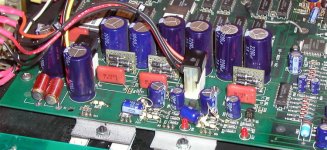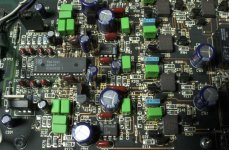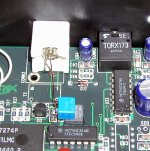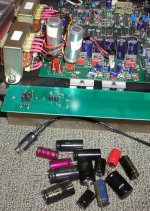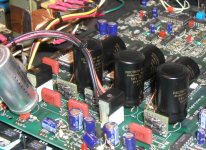rfbrw said:Short of running it over with a steamroller, I can't see how you can make it sound that bad.
I'm not sure what you mean by bad, maybe your previous experiences. As you see, I'm pretty much open to anything and if I can try something, I always do.
I had (unmodified) Bidat in my system the whole weekend, and today I switched back to my (modified) NOS TDA1543. Read my lips: if you value the emotional content of musical reproduction, immediacy, involvement, finer detail, PRAT, the Bidat does not even come close. Well, I had to spend $1800 to learn about it.
Comparisons aside, I still feel that the unit has quite potential and when modified it may become much more listenable. By listenable, I mean a way of musical presentation where each musical note exists in each own space and expresses exact intentions of a performer. Unfortunately, I cannot perceive it using the Bidat presently. It produces nice background music, but it's not satisfying to the full extend of what's possible.
Peter Daniel said:
the Bidat does not even come close.
I'm curious if you're utilizing the Museatex CD-D transport with C-Lock to the BIDAT.
I found the BIDAT always sounded best patched balanced into a true balanced amp, and utilizing the BIDAT wired remote. This is the closest I got it to comparing with modern day magic. I agree that this unit likely has much hidden potential.
-Rob
I'm using modified ML37 as transport (presently it sounds better than my other ML31.5).
The balanced Bidat output is connected to S&B TX102 (in balanced mode), and to Patek amp in bridged mode.
I was checking last night Audioasylum posts on bidat, apparently the DAC remote volume control is not that desirable.
I don't want to be misunderstood, I'm not saying that Bidat is no good, it's just that being spoiled by _well implemented_ NOS TDA1543 in proper setup, I'm not that easily satisfied these days 😉
The balanced Bidat output is connected to S&B TX102 (in balanced mode), and to Patek amp in bridged mode.
I was checking last night Audioasylum posts on bidat, apparently the DAC remote volume control is not that desirable.
I don't want to be misunderstood, I'm not saying that Bidat is no good, it's just that being spoiled by _well implemented_ NOS TDA1543 in proper setup, I'm not that easily satisfied these days 😉
My impression of Bidat sound over the last two days is the certain rightness without all the usual whistles and bells. It is the sound that is rather correct, yet not "impressive" enough to grab your attention and keep you in your chair thinking how could you live without it for so long. You won't find here unfamiliar sounds you had never heard before on your favourite CDs and probably won't find yourself tapping toes.
It is still the sound that is not much spoiled by digital processing and it still gives a promise of a great potential to be unleashed.
When I switched to Bidat I thought it was less colored, yet after switching back to TDA1543, I don't feel the coloration is here either. But I feel like the curtain was lifted and all the music is finally unleashed as well. 😉
It is still the sound that is not much spoiled by digital processing and it still gives a promise of a great potential to be unleashed.
When I switched to Bidat I thought it was less colored, yet after switching back to TDA1543, I don't feel the coloration is here either. But I feel like the curtain was lifted and all the music is finally unleashed as well. 😉
Peter Daniel said:I'm using modified ML37 as transport (presently it sounds better than my other ML31.5).
I find the BIDAT only excells driven by the CD-D. Meitner's C-Lock mechanism provides admirable jitter specs... (Other opinions on trnsports vary widely here.)
From the BIDAT manual, ( http://www.museatex.com/bidatman.htm ):
Jitter: Less than 10 PS. No periodic jitter. Crystal based PLL clock recovery system.
"Sounds which have been digitally recorded (i.e. quantized in time and magnitude into digital words) must be decoded at an equivalent sample rate and magnitude in order to accurately reproduce the original sounds. The stability of the sample rate clock directly affects the accuracy of conversion and it is easily shown by calculation that the required clock stability at 8Fs can be no worse than 50pS peak-to-peak in order to achieve 16-bit accuracy. This kind of deviation from perfect clock stability is called phase jitter or time jitter.
The accumulation of jitter through the playback chain is examined in a AES technical paper entitled "Time Distortions within Digital Audio due to Integrated Circuit Logic Induced Modulation (LIM) Products" in which the mechanism of jitter propagation called LIM is identified and a Museatex measurement tool for jitter analysis is introduced.
This research has led to the development of a series of proprietary Museatex circuits which prevent or reduce jitter in digital audio systems. An audio D-to-A converter must by necessity derive its timebase from the input audio data. The recovery of this clock is usually performed by one of a handful of standard IC's, all of which are sensitive to degradation of stability by every component of the preceding playback chain including the interconnecting digital cables. Yet the overall performance of the converter depends critically on the clocking of the conversion IC's with a clock having very low jitter.
C-Lock-R™ is a proprietary data receiver which uses a radically different clock recovery method. It has low sensitivity to jitter and LIM products carried in the received data stream. This provides the Bidat with low- jitter system clocks having high immunity to LIM and jitter caused by the sourcing equipment. Furthermore, this circuit ensures that any remaining jitter has a random or "white" frequency distribution allowing for clock distortion accuracy below the 20-bit level.
Museatex has made this receiver available under license to interested parties.
C-Lock-T™ is a proprietary reclocking circuit which ensures that jitter is removed from digital outputs. This circuitry has received critical praise as used in the Museatex Melior CD-Deck, a unit which outputs a fraction of the jitter produced by competing high performance drives costing many times more.
Other C-Lock™ jitter attenuators are used to ensure that the D-to-A conversion IC's in the Bidat are driven with sufficiently stable clocks."
I was checking last night Audioasylum posts on bidat, apparently the DAC remote volume control is not that desirable.
[/QUOTE]
The BIDAT wired remote works by controlling the reference voltages at the D/A converter. It does not attenuate the digital signal as many do. None the less, I've found the BIDAT does seem to sound best with the gain stage fairly wide open with the right amp/speaker pairing, but is no slouch greatly attenuated internally, (VS adding pre/attenuators.)
-Rob
Not being a fan of the DAC7 chipset, were I to ever own one of these, I would give serious consideration to trying out a different dac probably the AD1862 or the PCM63.
Peter Daniel said:Thanks for the pics. Aside from SMPS PS (and some small caps) everything else looks the same. My software ver. is R1.5.
I will be heavily modifying that unit soon, to hopefuly bring its certain performance aspects closer to what I'm used to with NOS TDA1543 DAC😉
Looking at your pic's, the technical description, and the DSP filter/ DAC 7 chipset I can't see what there is to modify!
I'd try to see if there is a software update / new chip for the DSP filter. Tda1543 sound version ?
By heavily modifying I assume you mean patching in a td1543 dac on to the saa7274 receiver?
ash_dac said:By heavily modifying I assume you mean patching in a td1543 dac on to the saa7274 receiver?
No, I actually mean redesigning completely PS and output stage, as well tuning the DAC auxilary components.
Tonight I did the first step into modding and changed the rectifiers,as well removed all those ceramic bypasses (on bridges).
And I already begin to like the DAC: the sound gained immediacy and is more open.
I used RGP 15B I was using previously with good results in a transport.
And I already begin to like the DAC: the sound gained immediacy and is more open.
I used RGP 15B I was using previously with good results in a transport.
Attachments
Peter Daniel said:Tonight I did the first step into modding and changed the rectifiers,as well removed all those ceramic bypasses (on bridges).
And I already begin to like the DAC: the sound gained immediacy and is more open.
I used RGP 15B I was using previously with good results in a transport.
Not a fan of FREDs? I like your daughterboard implementation.
Any idea why Meitner put those little antenna posts on leg 1 (?) of some of the ICs?
They more I peruse the guts of the BIDAT, the more impressed I am with Meitner's engineering.
-Rob
Meitner today: http://www.emmlabs.com/
The EMM DAC6:
Attachments
Hi,
See this thread: http://www.diyaudio.com/forums/showthread.php?s=&threadid=53400&highlight=SAA7350
and this paper:- http://www.essex.ac.uk/ese/research/audio_lab/malcolmspubdocs/C58 Techniques in DAC.pdf
( http://www.essex.ac.uk/ese/research/audio_lab/malcolms_publications.html )
Is the BIDAT a dual differential tda1547 design ?
See this thread: http://www.diyaudio.com/forums/showthread.php?s=&threadid=53400&highlight=SAA7350
and this paper:- http://www.essex.ac.uk/ese/research/audio_lab/malcolmspubdocs/C58 Techniques in DAC.pdf
( http://www.essex.ac.uk/ese/research/audio_lab/malcolms_publications.html )
Is the BIDAT a dual differential tda1547 design ?
come on guys
you guys are looking at a God awfull old stock bidat an bitching that it does not sound any good. Come on give me break!!!! Regards Moray James.
you guys are looking at a God awfull old stock bidat an bitching that it does not sound any good. Come on give me break!!!! Regards Moray James.
Re: come on guys
Maybe you could post some pictures of more recent stock?
moray james said:you guys are looking at a God awfull old stock bidat an bitching that it does not sound any good. Come on give me break!!!! Regards Moray James.
Maybe you could post some pictures of more recent stock?
ash_dac said:
Is the BIDAT a dual differential tda1547 design ?
Just one 1547, see pic...
Attachments
The implementation of DAC section in Bidat more or less follows the TDA1547 datasheet: http://www.semiconductors.philips.com/acrobat_download/datasheets/TDA1547_CNV_2.pdf
Rob Thomas said:
Just one 1547, see pic...
Hi,
Are you going to replace the LF353 ?
Not sure which Analogue Devices chip is the enhanced replacement for LF353.
I spent whole day yesterday modifying the board. In terms of transparency and immediacy the biggest improvement was brought by changing rectifiers and removing input transformer on SPDIF input. Before any mods, I much preferred Apogee Wyde Eye interconnect, after the mods, Kimber Illuminations D-60 is much better.
In the input section, the digital signal goes through crappy RCA, coupling transformer, SMD cap and resistor.
Changing for BNC jack didn't bring much difference. I used 75 ohm type, D-K part# A24602. I didn't drill holes to mount it on the board (4 layer board), but simply attached connector to the board with double sided tape. Please note that the original RCA has center pin connected to the shell, not input. Also, the ground from the RCA connect through 100R resistor to circuit ground.
My mods included removing completely the transformer, installing Vishay/ROE coupling cap (IMO best copuling cap for digital applications), terminating input with 75R Caddock MK132 resistor and connecting BNC ground directly to circuit ground. The DAC won't lock without coupling cap (even with my transport having output transformer installed).
This is very important mod and highly recommended. The hole in rear panel needs to be enlarged to 1/2"
In the input section, the digital signal goes through crappy RCA, coupling transformer, SMD cap and resistor.
Changing for BNC jack didn't bring much difference. I used 75 ohm type, D-K part# A24602. I didn't drill holes to mount it on the board (4 layer board), but simply attached connector to the board with double sided tape. Please note that the original RCA has center pin connected to the shell, not input. Also, the ground from the RCA connect through 100R resistor to circuit ground.
My mods included removing completely the transformer, installing Vishay/ROE coupling cap (IMO best copuling cap for digital applications), terminating input with 75R Caddock MK132 resistor and connecting BNC ground directly to circuit ground. The DAC won't lock without coupling cap (even with my transport having output transformer installed).
This is very important mod and highly recommended. The hole in rear panel needs to be enlarged to 1/2"
Attachments
All main caps in PS filtering are in CRC configuration, in pairs with 5R resistor in between.
I started swapping caps with 4700uF in 5V supply. It was not easy to pick up the right sounding ones, nothing really blended well (including 1000uf BG N) , eventually I settled on 2200/16 Sprague Extralytics. While I didn't like those caps in some other applications, here they seemed better then all the rest (BTW Nichicon KZ simply sucked here). Those are quite large caps and it's not easy to find a space for them. One is mounted permanently, the other not, as I still need an access to regulator circuits for further mods. As usually, I don't have problem with installing much smaller caps than originally.
I started swapping caps with 4700uF in 5V supply. It was not easy to pick up the right sounding ones, nothing really blended well (including 1000uf BG N) , eventually I settled on 2200/16 Sprague Extralytics. While I didn't like those caps in some other applications, here they seemed better then all the rest (BTW Nichicon KZ simply sucked here). Those are quite large caps and it's not easy to find a space for them. One is mounted permanently, the other not, as I still need an access to regulator circuits for further mods. As usually, I don't have problem with installing much smaller caps than originally.
Attachments
There are 3 more cap pairs on main filtering, and here nothing was really good, except for BG N 1000/50. Those caps are pretty expensive, at $60/pc, but working on greatest DAC of all times cannot be budget limited, if you know what I mean 😉
BTW, the differences with those caps are not really day and night, but more of a finer refinement type. With lesser quality caps , you may get more coloration, less satisfying tonal balance, more or less brightness, and overall less musicality. While BG N seem to soften sound a bit, they also have tendency to present the music in very natural way, they actually much less colored than other caps I tried so far.
It was also pretty easy to implement them here.
BTW, the differences with those caps are not really day and night, but more of a finer refinement type. With lesser quality caps , you may get more coloration, less satisfying tonal balance, more or less brightness, and overall less musicality. While BG N seem to soften sound a bit, they also have tendency to present the music in very natural way, they actually much less colored than other caps I tried so far.
It was also pretty easy to implement them here.
Attachments
- Home
- Source & Line
- Digital Source
- BiDAT/Meitner/MuseaTex/
